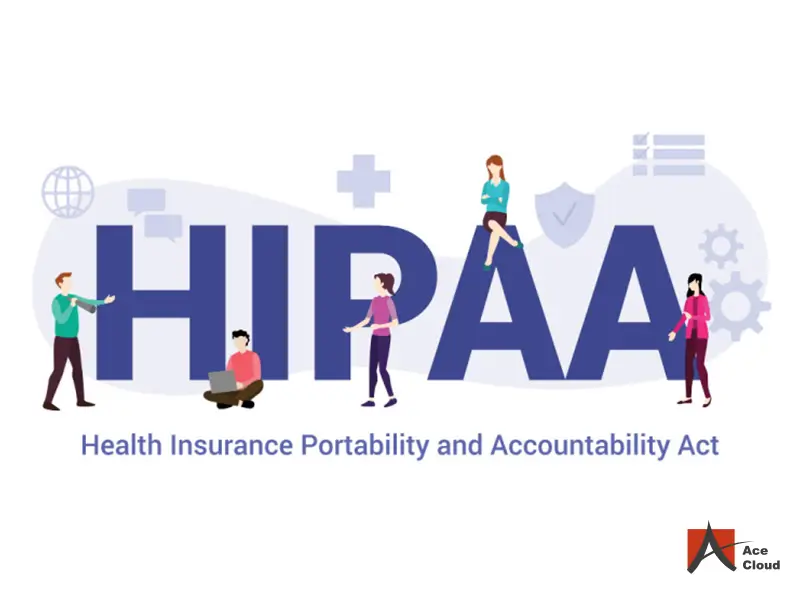Do you want to make your website compliant with GDPR and HIPAA? If you are looking for a tutorial, keep reading this article.
When running an online business dealing with customer’s personal information, you should ensure the business complies with legal laws. Otherwise, you could expect a heavy fine.
Most people forget to make their websites compliant with specific laws, which can be very damaging. We have developed this tutorial to help you optimize your website for GDPR and HIPAA.
Here, we will show you six methods for ensuring your website complies with GDPR and HIPAA.
First, let’s look at GDPR and HIPAA.
Table of Contents
GDPR: An Introduction

The General Data Protection Regulation (GDPR) is a comprehensive data protection law implemented in the European Union (EU) in 2018.
Its primary goal is to protect EU citizens’ privacy and personal data and give them more control over their information and how it is used. GDPR applies to any organization, regardless of location, that processes the personal data of EU citizens.
GDPR ensures that organizations handle personal data responsibly and comply with strict privacy and security standards. Non-compliance with GDPR can result in significant fines, penalties, and damage to an organization’s reputation.
By adhering to GDPR, organizations can demonstrate their commitment to protecting individuals’ data and maintaining trust.
HIPAA: An Introduction

The Health Insurance Portability and Accountability Act (HIPAA) is a federal law enacted in the United States in 1996.
Its primary goal is to protect the privacy and security of individuals’ health information, known as Protected Health Information (PHI). HIPAA applies to healthcare providers, health plans, clearinghouses, and business associates.
HIPAA is essential for safeguarding individuals’ health information from unauthorized access, use, or disclosure. It ensures that sensitive data is handled responsibly and complies with strict security and privacy standards.
Non-compliance with HIPAA can result in significant fines, penalties, and damage to an organization’s reputation.
GDPR vs HIPAA: What Are the Main Differences
Now you know what GDPR and HIPAA are. To simplify things, here is a quick comparison:
- Scope
- GDPR: Applies to all personal data of EU citizens, regardless of the organization’s location.
- HIPAA: Applies to individuals’ health information in the United States, specifically to covered entities and their business associates.
- Data Types
- GDPR: Covers a broad range of personal data, including names, addresses, IP addresses, and online identifiers.
- HIPAA: Specifically focuses on Protected Health Information (PHI), such as medical records, treatment plans, and health insurance information.
- Consent
- GDPR: Requires explicit consent for data processing, with individuals having the right to withdraw consent at any time.
- HIPAA: Consent is not always necessary, as HIPAA allows using PHI for treatment, payment, and healthcare operations without explicit consent.
- Data Subjects’ Rights
- GDPR: Provides individuals with extensive rights, such as the right to access, rectify, erase, restrict, or object to the processing of their data.
- HIPAA: Offers limited rights, such as the right to access and amend their health information, but does not include the right to restrict or object to processing.
- Penalties
- GDPR: Can impose fines of up to €20 million or 4% of the organization’s global annual revenue, whichever is higher.
- HIPAA: Can impose civil penalties of up to $50,000 per violation, with a maximum penalty of $1.5 million per year for the same violation.
The next section will show you how to make your website compliant with GDPR and HIPAA.
How to Make Your Website Compliant with GDPR and HIPAA
In a nutshell, the best methods to make your website compliant with GDPR and HIPAA are:
- Implement security measures
- Train your staff
- Conduct a data audit
- Develop a privacy policy
- Obtain consent
- Monitor and review
Below, we will show you how to implement each option.
Without any further ado, let’s get into the list.
1. Implement Security Measures
Implementing robust security measures is crucial for protecting the sensitive data your website collects. These measures include using encryption to secure data transmission and storage, regularly updating software to patch vulnerabilities, and having a robust firewall system.
Encryption is vital to data security, as it helps protect data from unauthorized access. By encrypting data both in transit and at rest, you can ensure that even if a security breach occurs, the data remains unreadable and unusable to unauthorized parties.
Regular software updates are essential for maintaining security, often including patches for known vulnerabilities. By keeping your software up-to-date, you can minimize the risk of exploitation by hackers and other malicious actors.
Another critical security measure is a robust firewall system. Firewalls help protect your website from unauthorized access and can be configured to block suspicious traffic, preventing potential security threats from reaching it.
2. Train Your Staff
Training your staff on GDPR and HIPAA compliance is crucial for ensuring that your organization handles personal data responsibly and complies with these regulations. Start by providing an overview of GDPR and HIPAA, including their key principles and requirements.
This will help your staff understand the importance of data protection and their role in maintaining compliance. Next, educate your staff on data handling best practices, such as obtaining consent, maintaining data accuracy, and ensuring data security.
This will help them understand how to process personal data competently. For example, they should be aware of the importance of obtaining explicit consent for data processing and the rights of data subjects under GDPR and HIPAA.
Training should also cover data breach response, including the steps to report the incident and notify affected individuals. This will help minimize the impact of a breach and ensure compliance with GDPR and HIPAA requirements.
Following your organization’s established procedures, staff should know how to respond to a data breach promptly and effectively. Implement a regular training schedule to ensure your staff stays updated on GDPR and HIPAA regulations.
This can include refresher courses, workshops, and updates on any regulation changes. Regular training will help your staff stay informed about the latest developments in data protection and maintain compliance with these regulations.
3. Conduct a Data Audit
Conducting a data audit for GDPR and HIPAA compliance involves several key steps. First, it’s essential to identify all the personal data your organization collects, processes, or stores. This includes user information, cookies, and any third-party services used.
Understanding what data you collect and how it is used is crucial for ensuring compliance with both regulations. Next, it’s important to review your data collection and processing practices to ensure they align with the requirements of GDPR and HIPAA.
This includes evaluating the use of consent forms, data subject rights, and data breach notification procedures. By assessing your data handling practices, you can identify compliance gaps and areas for improvement. Implementing robust security measures is also a critical component of a data audit.
This includes using encryption to secure data transmission and storage, regularly updating software to patch vulnerabilities, and having a robust firewall system. By evaluating your organization’s data security measures, you can ensure the confidentiality, integrity, and availability of the data you collect.
4. Develop a Privacy Policy
To develop a comprehensive privacy policy, start by identifying the types of data your website collects, including personal, sensitive, and health information.
This will help you understand the scope of your privacy policy and the requirements of GDPR and HIPAA regulations. Next, outline the purpose of data collection, such as providing services, improving user experience, or marketing.
This will help users understand why their data is being collected and how it will be used. Explain how your website processes personal data, including any third-party services used.
This should include information on data security measures, data retention policies, and data breach notification procedures. Users should also be informed of their rights under GDPR and HIPAA, such as the right to access, rectify, or erase their data and the right to object to the processing of their data.
If required, outline the process for obtaining consent for data processing. This should include information on how consent is obtained, the right to withdraw consent, and the consequences of not providing consent.
Provide contact information for your organization’s Data Protection Officer (DPO) or other relevant personnel so users can ask questions or report concerns about their data. Regularly review and update your privacy policy to ensure it remains compliant with GDPR and HIPAA regulations and reflects any changes to your data collection and processing practices.
5. Obtain Consent
Obtaining consent is a crucial aspect of compliance with both GDPR and HIPAA regulations. Consent must be freely given, specific, informed, and unambiguous, and it must be as easy to withdraw as it is to give.
Under GDPR, consent must be obtained for the processing of personal data. This includes obtaining explicit consent for specific purposes, such as marketing or sharing data with third parties. The consent must be given freely, and the individual must be informed of their rights, including the right to withdraw consent at any time.
In most cases, HIPAA does not require consent to process protected health information (PHI). However, there are exceptions, such as when marketing is involved, and the individual has the right to opt out of specific uses or disclosures of their PHI.
6. Monitor and Review
Monitoring and reviewing your website’s compliance with GDPR and HIPAA regulations is an ongoing process that involves regular audits, updates, and improvements to ensure ongoing compliance and data protection.
Regular audits are essential for identifying compliance gaps and areas for improvement. This includes reviewing your data handling practices, security measures, and data retention policies to ensure they align with the requirements of GDPR and HIPAA.
A robust data breach response plan is crucial for ensuring compliance with GDPR and HIPAA regulations. This includes having a process for identifying, reporting, and responding to data breaches and notifying affected individuals and authorities as required.
Monitoring and reviewing your website’s compliance with GDPR and HIPAA regulations is an ongoing process that requires continuous improvement. This includes regularly assessing your data protection practices, identifying areas for improvement, and implementing changes to ensure ongoing compliance and data protection.
Conclusion
Personal data is a valuable commodity. Websites must prioritize protecting user information. The General Data Protection Regulation (GDPR) and the Health Insurance Portability and Accountability Act (HIPAA) are two critical data protection regulations that require compliance from organizations that handle personal data, including websites.
Compliance with GDPR and HIPAA is a legal requirement and a moral obligation to protect the privacy and security of your users’ data. By implementing the necessary security measures and data protection policies, your website can maintain the trust of your users and avoid potential legal issues.
Do you know any other methods we should add to this article?
Let us know in the comments.



